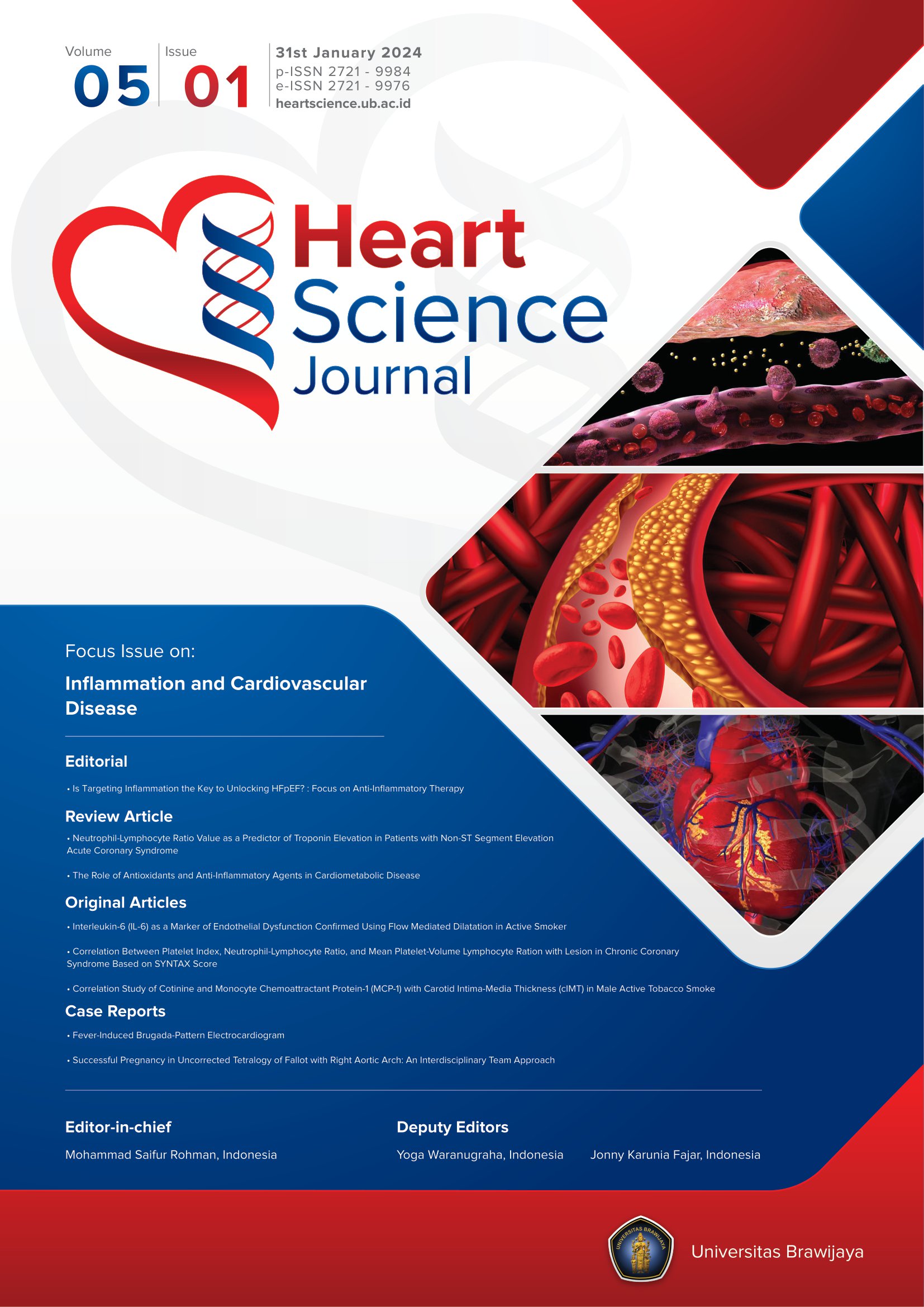Community-based Cardiac Rehabilitation Improved Adherence to Medication, Quality of Life and Rehospitalization Among Stable Coronary Artery Patients: A Cohort Study
Abstract
Background : Community-based cardiac rehabilitation interventions have been known as an important aspect of secondary prevention. However, no data are available regarding the benefit of this program in Indonesian coronary artery disease (CAD) patients treated with optimal medication.
Objectives : To assess the benefit of community-based cardiac rehabilitation on patient adherence to the drugs, quality of life (QoL) and MACE, in stable CAD.
Methods : An observational prospective cohort study recruited the Malang community of cardiovascular care (MC3) members as an intervention group and Aisyah Islamic hospital patients in Malang, Indonesia, as a control, for a year follow up. Member of MC3 has regular aerobic exercise, education regarding the disease, the importance of the drugs, and its side effect in addition to standard education given in outpatient clinic setting as the control group members. A validated MMS-8, QOL (SF-36), and SAQ questionnaire were used to assess adherence to the drugs, QoL, and MACE of participants.
Results: A total of 73 interventions and 73 control patients were enrolled for the study. Our findings showed that intervention patients were 2.04-fold associated with having a better physical function and 3.85-fold better compliance than control patients. The hospitalization rate also significantly lower in members of the intervention group (MC3). However, no significant difference observed among the two groups. Moreover, in the subgroup analysis, it shows that the intervention group who had participated for 2 years had the highest value of MMS-8 compared to the other groups with p < 0.005.
Conclusion: Our study reveals that community based cardiac rehabilitation intervention have better adherence to medication and quality of life than patients control, and also could reduce rehospitalization in stable CAD patients.
Keywords
Full Text:
PDFReferences
References
Bonow, Braunwald’s Heart Disease - A Textbook of Cardiovascular Medicine. Philadelphia: Elsevier Saunders:, 2012. p299
Pusat Komunikasi Publik Sekretariat Jenderal Kementerian Kesehatan RI. http://www.depkes.go.id/article/view/201410080002/lingkungan-sehat-jantung-sehat.html#sthash.8rONhkYv.dpuf
Atmiroseva. Inpatient Readmission Insidence of National Health Insurance Patients at Partner Hospitals of BPJS-Health in Sukabumi 2015. Journal of Indonesian health policy and administration; 2017. p20
Authors/Task Force m, Windecker S, Kolh P, Alfonso F, Collet JP, Cremer J, et al. 2014 ESC/EACTS Guidelines on myocardial revascularization: The Task Force on Myocardial Revascularization of the European Society of Cardiology (ESC) and the European Association for Cardio-Thoracic Surgery (EACTS)Developed with the special contribution of the European Association of Percutaneous Cardiovascular Interventions (EAPCI). Eur Heart J. 2014; 35(37):2541-619.
Pamala J, Cheng K. A systematic review and meta‐analysis on the effectiveness of education on medication adherence for patients with hypertension, hyperlipidaemia and diabetes. J Adv Nurs. 2019;00:1–17.
Muniez J, Gomez J, Perez S. The effect of post-discharge educational intervention on patients in achieving objectives in modifiable risk factors six months after discharge following an episode of acute coronary syndrome, (CAM-2 Project): a randomized controlled trial. Health and Quality of Life Outcomes 2010, 8:137
Piepoli MF, Corra U, Benzer W et al. Secondary prevention through cardiac rehabilitation: physical activity counseling and exercise training. European Heart Journal. 2010;31:1967-1976.
Sawhney JPS, Bagga S, Madan K. Cardiac rehabilitation in coronary artery disease. Cardiology society of India. 2016;3(20):135-140.
Niebauer J. Cardiac rehabilitation manual. Springer. 2011:151-162.
Dalal HM, Doherty P, Taylor RS. Cardiac rehabilitation. British Medical Journal. 2015;351:h5000.
Swain DP, Brawner CA, Chambliss HO et al. ACSM’s resource manual for guidelines for exercise testing and prescription seventh edition. Wolters Kluwer. 2014.
Dimulescu DR. When should cardiac rehabilitation be started after a cardiovascular event?. Medicographia. 2012;34(4):427-439.
Perk J, Mathes P, Gohlke H et al. Cardiovascular prevention and rehabilitation. Springer. 2007.
Gellis D, Kang Y. Meta-Analysis of the Effect of Cardiac Rehabilitation Interventions on Depression Outcomes in Adults 64 Years of Age and Older. Am J Cardiol 2012;110:1219–1224
Spertus JA, Winders JA, Dewhurst Ta. Development and Evaluation of the: A New Functional Status Measure for Coronary Artery Disease. JACC. 1995; 25 No 2:333-341.
Mosleh S, Bond C, Lee a. Effects of community based cardiac rehabilitation: Comparison with a hospital-based programme. European Journal of Cardiovascular Nursing 2015, Vol. 14(2) 108 –116
Calo R.O et all. Determinants of adherence to heart failure medication: a systematic literature review. Heart Fail Rev (2013) 18:409–427
DOI: https://doi.org/10.21776/ub.hsj.2020.001.02.5
Refbacks
- There are currently no refbacks.
Copyright (c) 2020 Heart Science Journal

This work is licensed under a Creative Commons Attribution 4.0 International License.









